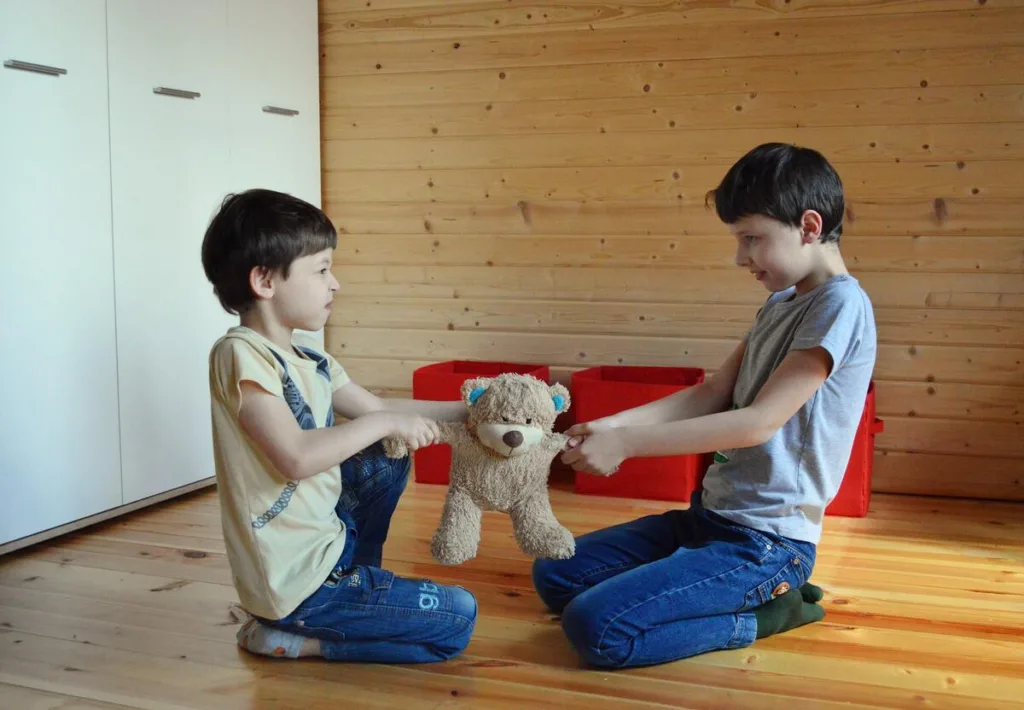Over time, the experiences and memories that siblings share may create strong life-long bonds, but they can also lead to long-lasting rivalries and conflicts. When kids are growing up under the same roof, these conflicts can range from petty squabbles over shared toys to deeper issues like jealousy or perceived favoritism.
With the right approach, you can teach your children valuable life skills, like empathy, conflict resolution, and effective communication. In this article, we will present some successful strategies to prevent and manage siblings fighting, to support your efforts in creating a harmonious and supportive family environment.
Understanding Sibling Dynamics – Why Do Siblings Fight?
Why do siblings fight? It may be the competition for parental attention, disagreements over possessions, or unmet expectations. These clashes can be linked to differences in personality, birth order, age gaps, and even the degree of genetic relatedness when talking about half or step-siblings. By acknowledging the relationship dynamic and underlying reasons for power struggles, parents can offer effective and personalized support for each child.
Personality clashes
Even though siblings grow up in the same family, each child is unique and brings their own individual temperament and personality to the family dynamic. One sibling might be more outgoing and assertive, while the other could be more introverted and reserved. These contrasting traits can lead to misunderstandings and disagreements. The more assertive sibling might be seen as bossy or overbearing, while the more reserved sibling might be seen as withdrawn or unsociable.
Siblings’ personality differences can lead to clashes when they react to or handle situations differently. For example, one sibling might prefer to discuss issues openly and immediately, while the other might need more time to process their emotions. These differences can lead to misunderstandings and siblings fighting if not recognized and managed effectively.
Birth order and spacing
‘Birth spacing’, or the difference in age between siblings, can greatly influence the frequency and causes of siblings fighting. When siblings are close in age, they tend to have more conflicts. This is not only because they are at similar developmental stages and may want the same things, like toys, time, or attention from their parents, but also because they have similar levels of reasoning and emotional regulation skills.

Credit: Photo By Victoria Rain on Pexels
Having similar reasoning skills means that they are likely to perceive situations in the same way. Take younger children for example. Siblings may want to play with the same toy at the same time, leading to conflicts over sharing. Moreover, being at comparable stages of emotional development means they might not yet fully understand how to regulate their feelings effectively, especially in the heat of the moment. They might struggle with taking turns, empathizing with each other’s point of view, or managing their feelings of frustration or jealousy, which can escalate disagreements into conflicts.
👉 Tired of your kids constantly fighting over sharing? Explore 5 effective techniques in our article to teach them the art of sharing. Discover how to bring harmony and cooperation back to your family!
Parenting styles and sibling conflict
Why do we see siblings fighting even though keep showing our disapproval? One big reason behind brotherly fights is to get their parents’ attention and benefits or establish a hierarchy, especially among kids close in age. For instance, siblings might compete to be the parent’s favorite or to assert dominance over one another.
Another factor that can contribute to sibling rivalry is labeling and favoritism. While parents may not consciously choose to favor one child over another, subtle behaviors can send powerful messages. For instance, an older sibling might be seen as more responsible and given more tasks, which could make younger siblings feel less important. It may be that the youngest child gets more attention, or parents bend family rules because of their age, making the older ones feel overlooked or treated unfairly.

Credit: Freepik
Scientific research supports the idea that parents are major influencers in how well siblings get along. Parents’ reactions to their children’s conflict, whether they mediate or ignore, can either defuse or inflame tensions. When parents ignore conflicts or fail to address them adequately, it may give rise to more severe issues. A neglectful attitude can prevent children from learning crucial conflict-resolution skills. They might grow up unable to handle disagreements healthily, which will impact their relationships later on.
Degree of relatedness
Why do siblings fight even when they’re not genetically related? Sibling conflict can present differently depending on whether they are full or half-siblings, primarily because of the varying dynamics within these relationships.
Full-siblings share both biological parents and generally spend more time together because they are living in the same house. They are often close in age and share the same resources (such as parents’ attention, toys, or space), leading to more opportunities for disagreements or conflicts. Full siblings may also be more likely to be compared to one another in terms of achievements, behaviors, and attitudes because they share the same genetic background. Parents, teachers, or even themselves might have higher expectations for similarities, and this comparison can foster rivalry and conflicts.
Half-siblings, who share only one parent, might face different challenges compared to full-siblings. They might not live together full-time, which can lessen daily opportunities for conflict. However, the dynamic can be complicated by factors such as age differences, relationships with the non-shared parent, and the presence of other full or step-siblings. For instance, half-siblings might have conflicts related to feeling left out or less favored compared to a full-sibling, particularly if one child spends more time with the shared parent than the other. Also, half-siblings might disagree with family rules or traditions, especially if they spend part of their time in different homes.
Blended families often require children to adjust to a new living situation, a new parent figure, and new brothers or sisters, which can be a significant source of stress and conflict. For instance, a child might feel resentment or jealousy towards a new step-sibling who seems to be getting more attention from their biological parent. Alternatively, a child might feel a sense of competition with the other kids over the affection of the new parent figure.
Sibling Rivalry vs. Sibling Abuse
In every family with more than one child, a certain level of sibling rivalry is almost inevitable. Most parents would like to know how to stop siblings from fighting for good, but unfortunately living together will always give them a reason to clash. Kids may argue over various issues – from simple disagreements about who gets the TV remote, bickering over toys, or competing for attention – to larger disputes about personal boundaries. With the right support, such arguments teach children essential life skills and healthy ways to compromise, negotiate, and empathize.

Credit: Photo by cottonbro studio on Pexels
However, if one child is constantly living in fear or being hurt, physically or emotionally, by the other, it’s a clear sign that what’s happening is beyond normal rivalry and could be sibling abuse. Signs of abuse include a sudden change in behavior or academic performance, unexplained injuries, or obvious physical aggression. It can go as far as the victim avoiding family interactions or not wanting to come home. Sibling violence is often dismissed as normal behavior or minimized within some families due to feelings of shame and guilt. This is the main attitude that fuels the behavior and makes it so harmful.
Parent intervention is crucial in differentiating between sibling rivalry and abuse. They must set boundaries that define acceptable behavior and pay close attention to their children’s interactions. Regular family meetings or professional family therapy can provide safe spaces for discussing concerns and reinforcing those boundaries. Protecting mental health and physical well-being should be a priority. Do not hesitate to seek professional help if you believe your child is experiencing or perpetrating sibling abuse. The earlier the intervention, the better the chance of resolving the issue and preventing long-term damage.
Effective Strategies for Preventing Sibling Conflicts
Sibling relationships are typically the first social connections and the ones that persist throughout our entire lives. These relationships’ quality is largely shaped by the family environment and dynamics in which they develop. Parents can significantly enhance the harmony and longevity of their children’s relationships by creating a supportive and positive family atmosphere, promoting open communication, and teaching solid conflict-resolution skills. Now that you’ve found out why do siblings fight, let’s explore what you can do to prevent these conflicts when they arise.
Establishing a Positive Family Environment
The home environment is the first “classroom” where kids pick up valuable life skills. They observe and learn from their surroundings, which can shape future healthy relationships and attitudes. If they grow up in a positive, nurturing home, they’re likely to recreate that environment in their adulthood. If a home is filled with love, respect, and open communication, children learn to value these qualities. They see these behaviors modeled by their parents and caregivers and naturally start to integrate them in their own interactions. They observe how disagreements are handled, emotions are expressed and managed, and decisions are made. When parents make decisions together, seek each other’s viewpoints, and don’t interrupt each other, children observe that everyone’s opinion matters.

Credit: Image by Drazen Zigic on Freepik
Children growing up in a loving home observe everyday acts of kindness. They see their parents expressing love towards each other, towards them, and others. They notice their parents taking care of each other, comforting each other in times of stress, and celebrating each other’s achievements. These lessons will prove their value during sibling squabbles, where instead of escalating the situation, siblings might offer support and understanding, recognizing that everyone can have a bad day or make mistakes.
Communication and Active Listening
Managing sibling conflicts and other family disagreements requires patience and persistence. By promoting a culture of active listening, empathy, and respect, parents can guide their children through conflicts and equip them with the tools to prevent or manage strong emotions in a healthy way. Here are some practical tips for guiding open and honest discussions between siblings:

Credit: Freepik
- Create a Safe Space: Start by establishing a calm, non-judgmental space for discussions. Ensure each child knows they are entitled to their feelings and thoughts and that it’s okay to express them. Encourage them to articulate their issues without fear of being mocked or that their ideas and feelings will be dismissed.
- Active Listening: Practice active listening, which means fully concentrating, understanding, responding, and remembering what’s being said. It’s vital to pay attention to non-verbal cues like body language as well.
- Avoid Favoritism: Be careful not to take sides. Instead, guide your children toward a resolution that respects everyone’s feelings. It can be challenging, especially when one child’s argument seems more logical, but remember, it’s not about right or wrong; it’s about validating feelings and finding a mutually agreeable solution.
- Deep Breathing and Time Outs: Encourage using deep breathing techniques for everyone during discussions. If a conflict escalates, suggest a time-out or cool-down period. These breaks allows all parties to calm down, collect their thoughts, and approach the situation more constructively later.
Teaching Conflict Resolution Skills
As primary role models, parents should always keep in mind that their actions and reactions are constantly being observed and often imitated by their children. Young children, in particular, are profoundly impacted by their parents’ interactions with each other or other people in the family circle. Displaying effective and peaceful conflict resolution can have a lasting impact, teaching children essential social skills that contribute to healthier relationships throughout their lives.
When parents model healthy problem-solving skills—such as expressing their feelings calmly, listening to the other person’s perspective with empathy, apologizing when they’re wrong, or finding compromises—children are more likely to adopt these practices in their own interactions. They learn that conflicts are a part of life, even if we’re talking about siblings fighting, but how we handle them matters.
How to Stop Siblings from Fighting – 3 Steps to Resolve Sibling Conflicts
The following perspective is quite common: “I fought with my older siblings when we were kids, and now we’re the best of friends.”
Sure, many of us have grown out of those petty squabbles and disagreements. As we mature, we learn to see things from different perspectives, develop better emotional regulation skills, and often learn to appreciate our siblings more. However, it’s crucial to remember that the emotional tension children experience during these conflicts is real and can be quite stressful.
Kids should get support when dealing with the struggles of siblinghood. When things get too intense, parents should step in. They should encourage their kids to be understanding and empathetic. They should also show them how to solve problems effectively. So now that you know why do siblings fight and have learned how to prevent conflicts, let’s discuss what you can do when they’re in the middle of a fight!
1. Intervening in the Heat of the Moment
Minor disagreements or arguments over toys or chores are a typical part of growing up with siblings and can actually help children develop valuable skills like negotiation, compromise, and patience. On the other hand, behaviors such as persistent name-calling, physical aggression, or intentional emotional harm should be considered out of bounds. If the disagreement over the toy leads to one sibling hitting, pushing, or physically hurting the other, immediate intervention is required. Intentional emotional harm, like deliberately excluding a sibling from activities, mocking them with the intention to cause harm, or consistently ignoring them, also crosses the line. These actions are meant to hurt the other person and can lead to feelings of isolation and low self-worth.
Parents and caregivers must intervene, draw a firm line when noticing harmful behavior, and make it clear that these actions are unacceptable and will not be tolerated.
2. Encouraging Empathy and Understanding
Empathy and understanding can strengthen the sibling bond. When siblings learn to understand and respect each other’s feelings, they are more likely to be supportive and maintain close ties throughout their lives.
You know when people say, “Put yourself in their shoes”? Well, that advice works best when kids are calm and ready to listen, not in the middle of a fight. One way to teach kids about empathy is through games or stories. These can help them think about how they act and how others might feel.

Credit: Freepik
For younger kids, try choosing books, cartoons, or movies that show characters being kind and understanding. Little kids tend to copy what they see so be sure to expose them to age appropriate content only. For teenagers, real-life experiences can help teach empathy. Encourage them to volunteer in their community or join discussions about local problems. As they work to help solve these problems, they start to understand how important it is to think about everyone’s feelings and experiences.
The most important way kids learn empathy is from their parents or other close adults. So, be a good role model! Show empathy in your day-to-day actions, and your kids are likely to do the same. It’s ineffective to seek ways to find out how to stop siblings from fighting if you’re currently arguing with your own brother or sister and your child can witness it.
👉 Struggling because your kid doesn’t know how to self-regulate their emotions? Discover effective strategies reading this article about “Effective Emotional Self-Regulation Strategies for Kids“.
3. Collaborative Problem-Solving
Having a sibling provides a built-in partner for life’s adventures and challenges. A 2017 study on children aged 5-7 showed that playtime and day-to-day activities offer opportunities for brothers and sisters to strengthen their relationship and develop collaborative problem-solving skills. They learn about sharing, patience and cooperation. We can even add financial management and chore distribution, among other things.
Did you grow up with a sibling? Or maybe you had a very close friend. Remember when we were putting our allowance money together to buy a game or a present for mom? Or traded doing the dishes for mowing the lawn? That was collaborative problem solving. Every situation where siblings find the happy middle is worth celebrating and emphasizing. When you see them, make sure you call them out, compliment both kids, and reinforce this positive behavior. It will show them that these shared victories are valued and appreciated.
Conclusion
Why do siblings fight? Now you have a clearer picture. When you’re a parent trying to ease the tensions between your kids, it’s important to remember that your role is about more than just playing referee. It’s about showing them how to empathize, how to communicate effectively, and how to compromise. These skills will enable them to build healthier relationships, not just with their siblings and close family members, but with everyone they encounter throughout their lives.
Sign up for our upcoming online events. They provide an excellent opportunity to find out why do siblings fight, to ask questions, share experiences, and learn from experts and other parents on their learning journeys.
Need a quick practical advice on siblings fighting or another parenting issue you are dealing with now? Our friendly AI assistant, Sophie, is here to answer any question.
Reference list
Elliott, K., Fitz-Gibbon, K., & Maher, J. (2020). Sibling violence: Understanding experiences, impacts, and the need for nuanced responses. The British Journal of Sociology, 71(1), 168-182. https://doi.org/10.1111/1468-4446.12712
Hoppe, W., Koch, J., Keeler, C., Waller, R., Habel, U., Sijben, R., & Wagels, L. (2023). The role of dominance in sibling relationships: Differences in interactive cooperative and competitive behavior. Scientific Reports, 13(1), 1-12. https://doi.org/10.1038/s41598-023-38936-7
Howe, N., Persram, R. J., & Recchia, H. E. (2020). Siblings and Sibling Rivalry. Encyclopedia of Infant and Early Childhood Development (Second Edition), 135-148. https://doi.org/10.1016/B978-0-12-809324-5.22835-6
Khan, R., Brewer, G., & Archer, J. (2020). Genetic Relatedness, Emotional Closeness and Physical Aggression: A Comparison of Full and Half Sibling Experiences. Europe’s Journal of Psychology, 16(1), 167-185. https://doi.org/10.5964/ejop.v16i1.1620
Kowal, A., & Kramer, L. (1997). Children’s Understanding of Parental Differential Treatment. Child Development, 68(1), 113-126. https://doi.org/10.1111/j.1467-8624.1997.tb01929.x
Kramer, L., Conger, K. J., Rogers, C. R., & Ravindran, N. (2019). Siblings. In B. H. Fiese, M. Celano, K. Deater-Deckard, E. N. Jouriles, & M. A. Whisman (Eds.), APA handbook of contemporary family psychology: Foundations, methods, and contemporary issues across the lifespan (pp. 521–538). American Psychological Association. https://doi.org/10.1037/0000099-029
Liu, C., & Rahman, M. N. (2022). Relationships between parenting style and sibling conflicts: A meta-analysis. Frontiers in Psychology, 13, 936253. https://doi.org/10.3389/fpsyg.2022.936253
McHale, S. M., Updegraff, K. A., & Whiteman, S. D. (2012). Sibling Relationships and Influences in Childhood and Adolescence. Journal of marriage and the family, 74(5), 913. https://doi.org/10.1111/j.1741-3737.2012.01011.x
Pike, A., & Oliver, B. R. (2017). Child Behavior and Sibling Relationship Quality: A Cross-Lagged Analysis. Journal of Family Psychology, 31(2), 250-255. https://doi.org/10.1037/fam0000248
Sang, S. A., & Nelson, J. A. (2017). The effect of siblings on children’s social skills and perspective taking. Infant and Child Development, 26(6), e2023. https://doi.org/10.1002/icd.2023
Whiteman, S. D., McHale, S. M., & Soli, A. (2011). Theoretical Perspectives on Sibling Relationships. Journal of family theory & review, 3(2), 124. https://doi.org/10.1111/j.1756-2589.2011.00087.x









